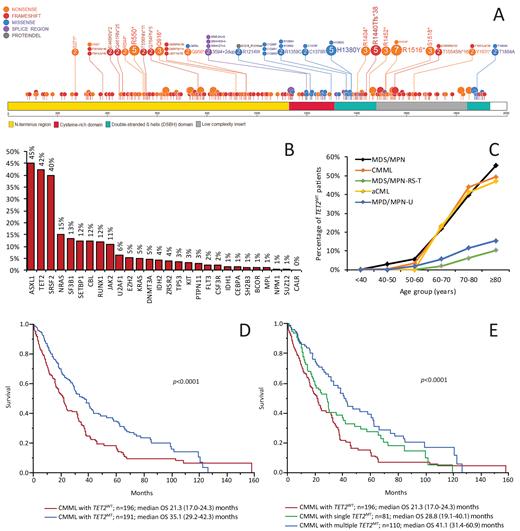Introduction: Myelodysplastic syndrome/myeloproliferative neoplasm (MDS/MPN) overlap syndromes consist of 5 distinct WHO-defined entities; namely chronic myelomonocytic leukemia (CMML), atypical chronic myeloid leukemia, BCR/ABL1- (aCML), juvenile myelomonocytic leukemia (JMML), MDS/MPN with ring sideroblasts and thrombocytosis (MDS/MPN-RS-T), and MDS/MPN, unclassifiable (MDS/MPN-U) (Arber et al., Blood 2016). With the notable exception of JMML, a bona fide RASopathy, the other entities are characterized by clinical heterogeneity and molecular diversity. Loss of function TET2 mutations (TET2MT) are common in myeloid neoplasms, especially CMML (60%), and are known leukemogenic drivers. We carried out this study to assess the TET2 mutational landscape and phenotypic correlates in patients with MDS/MPN overlap syndromes.
Methods: After approval by the institutional review board, adult patients with WHO defined MDS/MPN overlap syndromes were included; with the exception of JMML. The BM morphology, cytogenetics and 2016, WHO-diagnoses were retrospectively reviewed and all patients underwent targeted next generation sequencing for 29 myeloid-relevant genes, obtained on BM mononuclear cells, at diagnosis, or at first referral, by previously described methods (Patnaik et al., BCJ 2016).
Results: Five hundred and four patients were included in the study; including 387 (77%) with CMML, 48 (10%) with MDS/MPN-RS-T, 17 (3%) with aCML and 52 (10%) with MDS/MPN-U. The median age at diagnosis was 71 (range, 18-99) years, and 333 (66%) were male. TET2MT were seen in 212 (42%) patients, with the frequency of other mutations being: ASXL1 45%, SRSF2 40%, NRAS 15%, SF3B1 13%, CBL, RUNX1 and SETBP1 12% each, and JAK2 V617F 11% (Figure B). Among the MDS/MPN overlap syndromes, TET2 was more frequently mutated in CMML (49%) and aCML (47%) compared to MDS/MPN-RS-T (10%) and MDS/MPN-U (15%). The prevalence of patients with TET2MT increased with age, a finding consistent across all MDS/MPN subtypes (Figure C). Overall, 341 TET2MT were identified in 212 patients (mean 1.6 variants/patient, range 0-5): 120 (24%) had >1 TET2MT, while 113 (22%), 5 (1%) and 2 (0.4%) had 2, 3 and 5 mutations, respectively. CMML and aCML patients were more likely to have an age-independent increase in multiple TET2MT (28% and 24%), in comparison to MDS/MPN-RS-T (4%) and MDS/MPN-U (8%).
TET2MT spanned the entire coding sequence and were mostly truncating (78%, Figure A): 59 (17%) were missense, 14 (4%) involved the splice-donor/acceptor sites, 2 (0.5%) were in-frame deletions, 129 (38%) were nonsense, and 137 (40%) were frameshift mutations. Overall, the distribution of TET2MT was superimposable across CMML, aCML, and MDS/MPN-U; the only exception being the absence of splice site mutations in the latter two. One hundred and eighty-seven (55%) TET2MT were secondary to pathogenic single nucleotide variants (SNV), while the remainders were secondary to deletions (25%) and insertions (15%). Transitions comprised the most frequent type of SNV (65%), with the C:G>T:A being the most common (56%).
Patients with MDS/MPN overlap syndrome and TET2MT were more likely to have additional gene mutations compared to wild type patients (mean mutation number 3.1 vs 2.1, p<0.0001), with common co-mutations being SRSF2 (51%), ASXL1 (42%), and CBL (17%).
The median overall survival (OS) of the entire cohort was 29 (range, 0-170) months; 29 months for CMML, 63 months for MDS/MPN-RS-T, 14 months for aCML, and 25 months for MDS/MPN-U. On univariate analysis, OS was superior in CMML patients with TET2MT (35 months) compared to wild type cases (21 months, p<0.0001, Figure D), and in CMML patients with >1 TET2MT (41 months) in comparison to wild type (21 months, p<0.0001) and single TET2MT (29 months, p=0.0476) cases (Figure E). These observations were not seen in patients with aCML, MDS/MPN-RS-T, and MDS/MPN-U.
Conclusion: Our study demonstrates that TET2MT are among the most frequent mutations in patients with MDS/MPN overlap syndromes (42%), especially CMML (49%), with an age-dependent increase in the frequency and number of TET2MT. Mutations in TET2 were found to span the entire coding sequence, with truncating mutations being more common (78%). Importantly, in CMML, TET2MT, including number of TET2MT, were associated with favorable survival outcomes.
Al-Kali:Astex Pharmaceuticals, Inc.: Research Funding. Patnaik:Stem Line Pharmaceuticals.: Membership on an entity's Board of Directors or advisory committees.
Author notes
Asterisk with author names denotes non-ASH members.


This feature is available to Subscribers Only
Sign In or Create an Account Close Modal